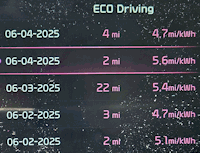Back-up open We managed to miss the Dodge Charger electric vehicle (EV) when we updated back-up open and start processes for 2024 and 2025 Dodge vehicles. But when we chased down drive by brake after reading about a problem Edmunds had with the car, we realized we missed a confounding issue with getting into the …
Category: Articles & Commentaries
Discussions on topics of interest to drivers concerning things they may not understand about their vehicles as well as articles on the future of the auto industry.
Permanent link to this article: https://dashboardsymbols.com/2025/06/dodge-adds-to-growing-list-of-troublesome-electronic-latches/
Permanent link to this article: https://dashboardsymbols.com/2025/06/charger-ev-presents-true-back-up-open-dilemma/
A final hodgepodge of regen braking questions
Regen braking Our search for common regen braking questions turned up several that require only the following short answers. — Does regenerative braking wear out tires faster? Regenerative braking has no impact on vehicle’s tires. Aggressive driving and hard braking with the friction brakes can cause damage to tires. — Should I use regenerative braking …
Permanent link to this article: https://dashboardsymbols.com/2025/06/a-final-hodgepodge-of-regen-braking-questions/
Drive by brake? What??
Drive by brake Last week, Edmunds reported that a 2025 Dodge Charger EV they’ve been testing began an unintended acceleration. This week Dodge produced an answer: drive by brake, which it turns out is a feature. Well this needed some digging. We’ve examined the car’s manual during our recent symbols update and had come across …
Permanent link to this article: https://dashboardsymbols.com/2025/06/drive-by-brake-what/
The two forms of auto brake hold
Brake hold We’ve now experienced two very different forms of Auto Brake Hold, and only recently adjusted the page to reflect it, 20 different images not withstanding. In any case, some manufacturers have the system active at all times. If the car is started, brake hold is ready to use by default. This was the …
Permanent link to this article: https://dashboardsymbols.com/2025/06/the-two-forms-of-auto-brake-hold/
The Niro is a summertime EV efficiency champ
EV efficiency EV efficiency, measured in miles per kWh (m/kWh), comes up short in the vast majority of electric vehicles. Most will see between three and four m/kWh, covered in some detail here. And the larger the electric vehicle, the lower the efficiency. The Kia Niro I am now driving, however, is a summertime efficiency …
Permanent link to this article: https://dashboardsymbols.com/2025/06/the-niro-is-a-summertime-ev-efficiency-champ/
Misunderstanding regenerative “brakes”
Regenerative “brakes” In researching common questions about regenerative “brakes”, it became clear that there are serious misconceptions about the topic, all of which surround the use of the word brakes or braking. Here are some all too common questions: How much longer do regenerative brakes last? Can regenerative brakes overheat? Does regenerative braking wear out …
Permanent link to this article: https://dashboardsymbols.com/2025/06/misunderstanding-regenerative-brakes/




Dodge adds to growing list of troublesome electronic latches
Electronic latches In 2024, the Dodge Charger went electric and electronic. The company’s first electric vehicle (EV) also follows the troublesome and rather pointless trend of using electronic latches in the doors. We say pointless because of course, the company had to create a mechanical back-up in case of a failure of the 12-volt battery, …
Continue reading